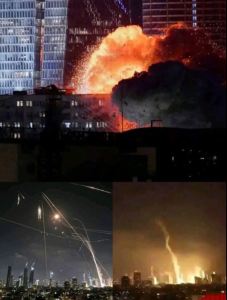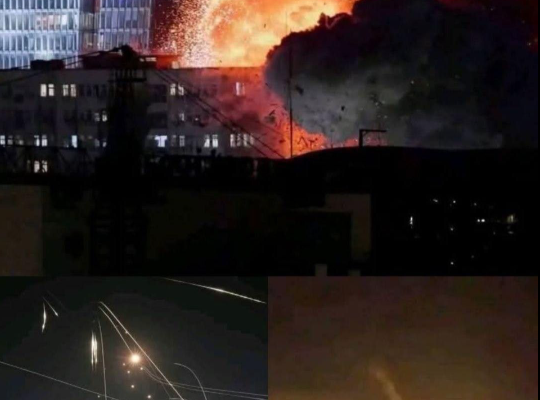Overview & Context
For nearly two years, Israel and Hamas (in Gaza) have been locked in a brutal conflict that began with the Hamas-led attack on Israel on October 7, 2023. The war has resulted in massive destruction, high civilian casualties, widespread displacement, and a humanitarian crisis in Gaza.
Recently, the fighting has intensified. Israel has ramped up military operations in Gaza City and across the Gaza Strip, under the stated aim of dismantling Hamas infrastructure and ending rocket fire and raids into Israeli territory. Meanwhile, diplomatic efforts—including a U.S.-proposed ceasefire plan—are ongoing, though their success remains highly uncertain
Recent Escalation & Military Moves
Intensified Strikes & Ground Operations
-
Since dawn, Israeli attacks have killed at least 61 people in Gaza.
-
Two missiles hit al-Falah School, which had been functioning as a shelter for displaced civilians.
-
In the Daraj and Zeitoun neighborhoods of Gaza City, additional strikes have caused casualties, including children
-
Israel has closed off al-Rashid Street (a critical northbound route), effectively cutting off northern Gaza from southern Gaza
-
The Israel Defense Forces (IDF) captured the Netzarim Corridor, further bisecting Gaza geographically.
These moves tighten siege and restrict civilian movement, making survival and evacuation extremely perilous for many.
Humanitarian & Medical Crisis
-
The Red Cross has reportedly suspended operations in Gaza City due to the intensity of conflict.
-
Many hospitals, including al-Quds, are surrounded or under fire; staff are depleted, and essential supplies (water, power, oxygen) are scarce or cut off.Some hospitals have had to reduce services drastically or evacuate parts of their operations.
-
In a recently released video, a nurse documented part of a hospital collapse under fire, highlighting the collapse of medical infrastructure
Naval Blockade & Flotilla Confrontations
-
A flotilla (Global Sumud Flotilla) carrying aid and activists—including Greta Thunberg—has attempted to break through Israel’s naval blockade of Gaza.
-
The flotilla reports harassment by Israeli naval forces: encirclement, disruption of communications, and other “intimidatory operations” in the approach zone.Italy has announced it will end naval escort of the flotilla once it comes within 150 nautical miles of Gaza, citing escalating risk.
Israel argues that the blockade is a necessary security measure, claiming that flotillas may deliver support to Hamas. Critics counter that it constitutes collective punishment of Gaza’s civilian population, and violates international law.
Diplomacy, Proposals & Political Tensions
U.S. Ceasefire Plan
-
The United States has proffered a 20-point ceasefire proposal, aimed at halting hostilities, exchanging hostages, and eventually facilitating Israeli withdrawal, with conditions on Hamas disarmament and governance
-
Israeli Prime Minister Netanyahu has accepted many elements of the plan; Hamas is still deliberating.
-
The U.S. has given Hamas a “few days” to respond; failure to do so is implicitly met with threats of continued intensification.
International Pressure & Shifting Support
-
Global criticism is mounting over the humanitarian toll in Gaza.
-
Microsoft (the tech company) has suspended some services to the Israeli Ministry of Defense, citing internal concerns over use of cloud services for surveillance in Gaza and the West Bank.
-
Public opinion in the U.S. appears shifting: new polling suggests a drop in American support for Israel amid rising awareness of civilian suffering
Regional & Cross-Border Dynamics
-
Israel has also targeted Iran-aligned actors. For example, it struck military sites in Sanaa, Yemen following a drone attack on Eilat.
-
Houthi forces (in Yemen) have launched drone or missile attacks at Israeli territory in solidarity with Palestinians.
-
Earlier this year, Iranian missiles struck the Soroka Hospital in Israel, injuring civilians and damaging medical facilities.
-
Hezbollah along Israel’s northern border (in Lebanon) remains a potential escalation front, with prior exchanges of fire and growing anxiety among Lebanese civilians of a renewed war.
Human Cost & Humanitarian Impact
Casualties, Displacement & Suffering
-
The death toll in Gaza since the conflict’s start is estimated to be over 66,000 people (though numbers vary by source)
-
Thousands more are injured; many are missing or unaccounted.
-
Displacement is massive: northern Gaza has become largely uninhabitable, with civilians streaming south—only to find overcrowded, under-resourced zones.
-
With the closure of key routes like al-Rashid Street, movement is restricted and dangerous.
Infrastructure & Essential Services
-
Power, water, sanitation, and fuel are severely disrupted, especially in Gaza City.
-
Schools and educational facilities are damaged or destroyed; many have been repurposed as shelters.
-
Telecommunications and communications infrastructure have been partially degraded.
-
Buildings are flattened or badly damaged; satellite and radar-based studies suggest that a majority of structures in northern Gaza have experienced damage.
Medical System Collapse
-
Hospitals report running out of basic supplies, closing wards, or halting operations entirely.
-
Some medical staff have had to evacuate.
-
The danger of remaining or moving amid bombings means that patients, especially those requiring ongoing care (dialysis, intensive care, surgeries), are at extreme ris
Key Challenges & Questions Ahead
-
Ceasefire Implementation: Even if Hamas accepts the U.S. plan, managing a ceasefire on the ground is fraught—ensuring compliance, disarming, and avoiding flare-ups will be difficult.
-
Civilians’ Safety and Accountability: With heavy urban warfare, distinguishing military from civilian zones is nearly impossible. Questions of war crimes, proportionality, and protection of civilians remain central.
-
Access for Humanitarian Aid: Aid must traverse conflict lines, ceasefire zones, naval blockades, and be safeguarded—yet many routes are closed or insecure.
-
Regional Spillover & Escalation: With multiple actors (Iran, Yemen’s Houthis, Lebanon/Hezbollah), there’s a risk of widening conflict beyond Gaza-Israel.
-
Post-conflict Reconstruction & Governance: If hostilities pause, how will Gaza rebuild? Who will govern, and how will security be maintained?
-
International Pressure & Legitimacy: How global institutions, governments, NGOs, and public opinion respond may influence both the immediate trajectory and the broader geopolitical alignment in the Middle East.


